Protoplanetary disk
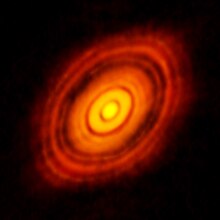
A protoplanetary disk is a rotating
Formation

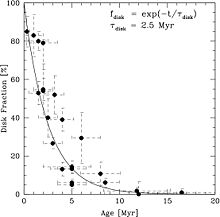
It is now a T Tauri star. Accretion of gas onto the star continues for another 10 million years,[6] before the disk disappears, perhaps being blown away by the young star's stellar wind, or perhaps simply ceasing to emit radiation after accretion has ended. The oldest protoplanetary disk yet discovered is 25 million years old.[7][8]
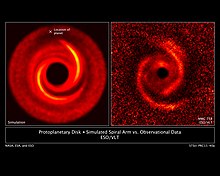
Protoplanetary disks around T Tauri stars differ from the disks surrounding the primary components of close binary systems with respect to their size and temperature. Protoplanetary disks have radii up to 1000
Protoplanetary disks have been observed around several young stars in our galaxy. Observations by the Hubble Space Telescope have shown proplyds and planetary disks to be forming within the Orion Nebula.[10][11]
Protoplanetary disks are thought to be thin structures, with a typical vertical height much smaller than the radius, and a typical mass much smaller than the central young star.[12]
The mass of a typical proto-planetary disk is dominated by its gas, however, the presence of dust grains has a major role in its evolution. Dust grains shield the mid-plane of the disk from energetic radiation from outer space that creates a dead zone in which the magnetorotational instability (MRI) no longer operates.[13][14]
It is believed that these disks consist of a turbulent envelope of plasma, also called the active zone, that encases an extensive region of quiescent gas called the dead zone.[14] The dead zone located at the mid-plane can slow down the flow of matter through the disk which prohibits achieving a steady state.
Planetary system
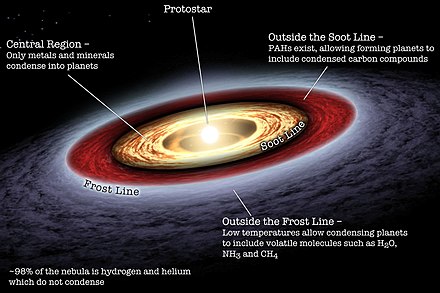
The

Some of the moons of
Debris disks
Gas-poor disks of circumstellar dust have been found around many nearby stars—most of which have ages in the range of ~10 million years (e.g.
Relation to abiogenesis
Based on recent
Gallery
-
Illustration of the dynamics of a proplyd
-
20 protoplanetary discs captured by the High Angular Resolution Project (DSHARP).[21]
-
A shadow is created by the protoplanetary disc surrounding the star HBC 672 within the nebula.[22]
-
Protoplanetary discOphiuchus star-forming region.[23]
-
By observing dusty protoplanetary discs, scientists investigate the first steps of planet formation.[25]
-
Concentric rings around young starHD 141569A, located some 370 light-years away.[26]
-
Protoplanetary diskstellar jet.
-
Artist's impression of a protoplanetary disk.
-
A proplyd in the Orion Nebula.
-
Video shows the evolution of the disc around a young star like HL Tauri (artist concept).
-
Image of the circumtrinary disc around GW Orionis.[28]
-
An artist's concept of a protoplanetary disk
See also
- Accretion disk
- Circumplanetary disk – Accumulation of matter around a planet
- Debris disk
- Disrupted planet
- Exoasteroid
- Formation and evolution of the Solar System
- Herbig–Haro object
- Nebular hypothesis
- Q-PACE, a spacecraft mission to study accretion
- Planetary system
References
- ^ Johnathan Webb (2014-11-06). "Planet formation captured in photo". BBC.
- ^ "Birth of Planets Revealed in Astonishing Detail in ALMA's 'Best Image Ever'". NRAO. 2014-11-06. Archived from the original on 2014-11-06.
- ^ "Early Evolution of Planetary Disk Structures Seen for the First Time". National Radio Astronomy Observatory. Retrieved 18 February 2024.
- S2CID 16660243.
- .
- S2CID 16366683.
- S2CID 17532904.
- ^ Cain, Fraser; Hartmann, Lee (3 August 2005). "Planetary Disk That Refuses to Grow Up (Interview with Lee Hartmann about the discovery)". Universe Today. Retrieved 1 June 2013.
- ^ "Protoplanetary Disk: Simulated Spiral Arm vs. Observational Data". Retrieved 30 October 2015.
- S2CID 123470043.
- ISSN 0004-6256.
- S2CID 55900935.
- doi:10.1086/170270. Archivedfrom the original on 2020-12-02.
- ^ doi:10.1086/176735. Archivedfrom the original on 2021-11-17.
- ^ "Stellar Outburst Brings Water Snow Line Into View". Retrieved 15 July 2016.
- S2CID 18964068.
- S2CID 118572605.
- ISBN 978-0-8165-2844-8.
- S2CID 119216797.
- ^ a b Moskowitz, Clara (29 March 2012). "Life's Building Blocks May Have Formed in Dust Around Young Sun". Space.com. Retrieved 30 March 2012.
- ^ "Pitch perfect in DSHARP at ALMA". www.eso.org. Retrieved 28 January 2019.
- ^ "Hubble reveals cosmic Bat Shadow in the Serpent's Tail". www.spacetelescope.org. Retrieved 5 November 2018.
- ^ "Young planet creates a scene". www.eso.org. Retrieved 26 February 2018.
- ^ "Feeding a Baby Star with a Dusty Hamburger". www.eso.org. Retrieved 15 May 2017.
- ^ "Spring Cleaning in an Infant Star System". www.eso.org. Retrieved 3 April 2017.
- ^ "Boulevard of Broken Rings". Retrieved 21 June 2016.
- ^ Harrington, J.D.; Villard, Ray (24 April 2014). "RELEASE 14-114 Astronomical Forensics Uncover Planetary Disks in NASA's Hubble Archive". NASA. Archived from the original on 2014-04-25. Retrieved 2014-04-25.
- .
Further reading
- Davis, Sanford S. (2006). "A New Model for Water Vapor and Ice Abundance in a Protoplanetary Nebula". American Astronomical Society, DPS Meeting #38, #66.07. 38: 617. Bibcode:2006DPS....38.6607D..
- Barrado y Navascues, D. (1998). "The Castor moving group: The age of Fomalhaut and Vega". Astronomy and Astrophysics. 339 (3): 831–839. Bibcode:1998A&A...339..831B. Archived from the originalon 2007-09-29. Retrieved 2007-06-22.
- S2CID 4406070.

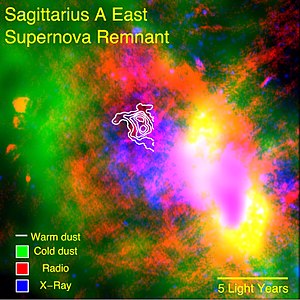
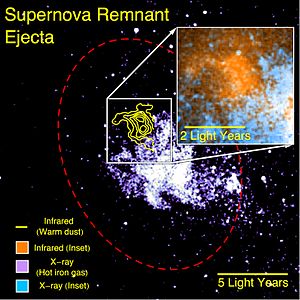
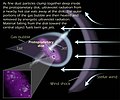
![20 protoplanetary discs captured by the High Angular Resolution Project (DSHARP).[21]](http://upload.wikimedia.org/wikipedia/commons/thumb/8/82/Pitch_perfect_in_DSHARP_at_ALMA.jpg/96px-Pitch_perfect_in_DSHARP_at_ALMA.jpg)
![A shadow is created by the protoplanetary disc surrounding the star HBC 672 within the nebula.[22]](http://upload.wikimedia.org/wikipedia/commons/thumb/d/dc/Cosmic_shadow_of_HBC_672.jpg/120px-Cosmic_shadow_of_HBC_672.jpg)
![Protoplanetary disc AS 209 nestled in the young Ophiuchus star-forming region.[23]](http://upload.wikimedia.org/wikipedia/commons/thumb/d/dc/Young_planet_creates_a_scene.jpg/120px-Young_planet_creates_a_scene.jpg)
![Protoplanetary disk HH 212.[24]](http://upload.wikimedia.org/wikipedia/commons/thumb/9/97/Feeding_a_Baby_Star_with_a_Dusty_Hamburger.jpg/120px-Feeding_a_Baby_Star_with_a_Dusty_Hamburger.jpg)
![By observing dusty protoplanetary discs, scientists investigate the first steps of planet formation.[25]](http://upload.wikimedia.org/wikipedia/commons/thumb/3/3a/Spring_Cleaning_in_an_Infant_Star_System.jpg/120px-Spring_Cleaning_in_an_Infant_Star_System.jpg)
![Concentric rings around young star HD 141569A, located some 370 light-years away.[26]](http://upload.wikimedia.org/wikipedia/commons/thumb/d/d6/Boulevard_of_Broken_Rings.jpg/120px-Boulevard_of_Broken_Rings.jpg)
![Debris disks detected in HST images of young stars, HD 141943 and HD 191089 - images at top; geometry at bottom.[27]](http://upload.wikimedia.org/wikipedia/commons/thumb/e/eb/NASA-14114-HubbleSpaceTelescope-DebrisDisks-20140424.jpg/120px-NASA-14114-HubbleSpaceTelescope-DebrisDisks-20140424.jpg)
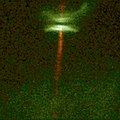


![Image of the circumtrinary disc around GW Orionis.[28]](http://upload.wikimedia.org/wikipedia/commons/thumb/5/5c/GW_Orionis_2.jpg/120px-GW_Orionis_2.jpg)
